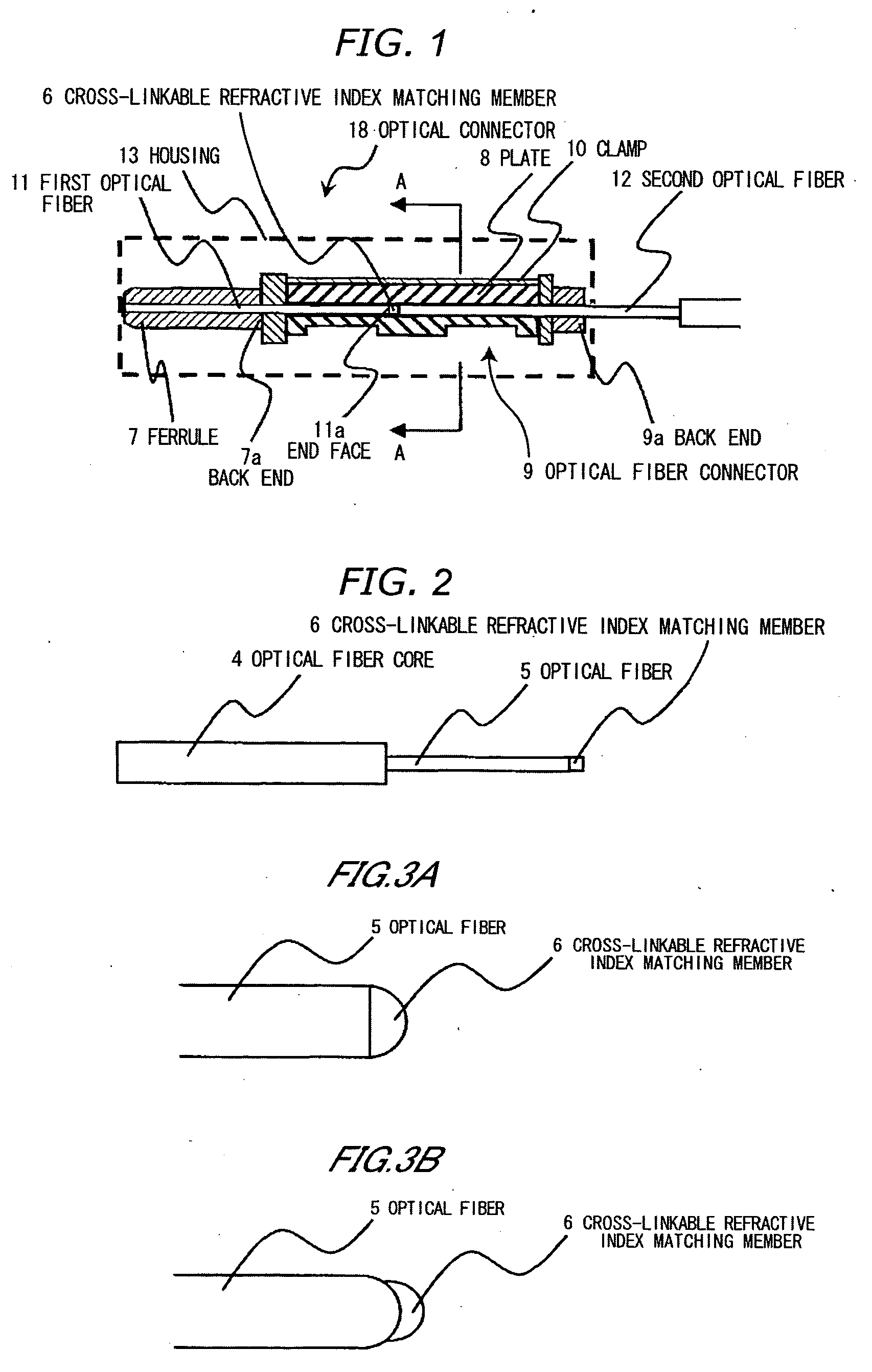Optical connector and connection structure of optical fibers
a technology of optical fibers and connectors, applied in the field of optical connectors, can solve the problems of increasing the loss of the end face profile of optical fibers can seriously affect the connection characteristics, and the method of polishing the end face of optical fibers or the ferrules is not suitable for connecting optical fibers, so as to facilitate the connection of optical fibers, reduce the number of changes, and the effect of easy removal
- Summary
- Abstract
- Description
- Claims
- Application Information
AI Technical Summary
Benefits of technology
Problems solved by technology
Method used
Image
Examples
example 1
[0083]As a cross-linkable refractive index matching agent, an ethyl acetate 50% solution of an acrylic resin 100 weight parts comprising n-butyl acrylate / methyl acrylate / acrylic acid / 2-hydroxyethylmethacrylate copolymer (compounding ratio=82 / 15 / 2.7 / 0.3 (weight part)) and a cross-linking agent 1.0 weight part manufactured by Nihon Polyurethane Industry Co., Ltd and marketed under a trade name of “coronate L” were compounded and mixed together.
[0084]An optical transmission in a wavelength range of 1300 to 1600 nm of an cross-linkable refractive index matching member obtained by cross-linking and hardening the acrylic adhesive coating solution (the cross-linkable refractive index matching agent) obtained as described above, was measured by a spectral photometer. As a result of the measurement, the optical transmission of 93 to 95% was obtained. And a refractive index thereof is also measured by an Abbe refraction meter, so that a refractive index of 1.465±0.005 or less at a room temper...
example 2
[0092]As a cross-linkable refractive index matching agent, an addition type silicone based adhesive material coating liquid comprising SD4590 / BY24-741 / SRX212 / toluene (compounding ratio=100 / 1.0 / 0.9 / 50 (weight part)) is prepared (all of SD4590, BY24-741 and SRX212 are manufactured by Dow Corning Toray Co., LTd).
[0093]An optical transmission in a wavelength range of 1300 to 1600 nm of an cross-linkable refractive index matching member obtained by cross-linking and hardening the addition type silicone based adhesive material coating liquid (the cross-linkable refractive index matching agent) obtained as described above, was measured by a spectral photometer. As a result of the measurement, the optical transmission of 92 to 94% was obtained. And a refractive index thereof is also measured by an Abbe refraction meter, so that a refractive index of 1.465±0.005 or less at a room temperature (23±2° C.) was obtained.
[0094]Further, a breaking elongation thereof is also measured, so that the br...
example 3
[0109]As a cross-linkable refractive index matching agent, an ethyl acetate 50% solution of an acrylic resin 100 weight parts comprising n-butyl acrylate / methyl acrylate / acrylic acid / 2-hydroxyethylmethacrylate copolymer (compounding ratio=82 / 15 / 2.7 / 0.3 (weight part)) and a cross-linking agent 1.0 weight part manufactured by Nihon Polyurethane Industry Co., Ltd and marketed under a trade name of “coronate L” were compounded and mixed together.
[0110]An optical transmission in a wavelength range of 1300 to 1600 nm of an cross-linkable refractive index matching member obtained by cross-linking and hardening the acrylic adhesive coating solution (the cross-linkable refractive index matching agent) obtained as described above, was measured by a spectral photometer. As a result of the measurement, the optical transmission of 93 to 95% was obtained. And a refractive index thereof is also measured by an Abbe refraction meter, so that a refractive index of 1.465±0.005 or less at a room temper...
PUM
 Login to View More
Login to View More Abstract
Description
Claims
Application Information
 Login to View More
Login to View More - R&D
- Intellectual Property
- Life Sciences
- Materials
- Tech Scout
- Unparalleled Data Quality
- Higher Quality Content
- 60% Fewer Hallucinations
Browse by: Latest US Patents, China's latest patents, Technical Efficacy Thesaurus, Application Domain, Technology Topic, Popular Technical Reports.
© 2025 PatSnap. All rights reserved.Legal|Privacy policy|Modern Slavery Act Transparency Statement|Sitemap|About US| Contact US: help@patsnap.com



